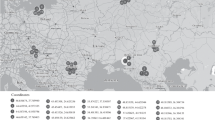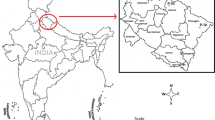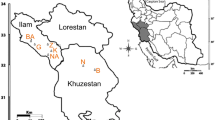Abstract
As a N2-fixing tree species, sea buckthorn (Hippophae rhamnoides) is well adapted to arid regions and is utilized for multiple purposes in China. Current knowledge of genetic variability of H. rhamnoides is limited in terms of rangewide distributions. Eleven natural populations of sea buckthorn in northeastern and northwestern China were analyzed to detect genetic variation among and within populations, by use of ISSR (inter-simple sequence repeats) markers. Using eight primers, 207 polymorphic loci were observed, ranging in size from 250 to 2500 bp. The coefficient of gene differentiation (Gst = 0.0679) showed that the total molecular variance of 11 populations was mainly existed within populations. The genetic variation within and among the 11 populations was 93.21 and 6.79%, respectively. No significant correlation between genetic and geographic distances of the populations was found using ISSR markers. Our study provides a population-level genetic profile for further investigation and conservation of genetic diversity of sea buckthorn.
Similar content being viewed by others
References
Aitzetmuller K. and Xin Y. 1999. Sea buckthorn and sea buckthorn oils — recent developments in China and central Asia. Nahrung. 43: 228–232.
Barrett S.C.H. and Kohn J.R. 1991. Genetic and evolutionary consequences of small population size in plants. Implications for Conservation. In: Falk and Holsinger (eds) Genetics and Conservation of Rare Plants. Oxford University Press, Oxford, pp. 3–30.
Bartish I.V., Jeppsson N. and Nybom H. 1999. Population genetic structure in the dioecious pioneer plant species Hippophae rhamnoides investigated by random amplified polymorphic DNA (RAPD) markers. Mol. Ecol. 8: 791–802.
Bartish I.V., Jeppsson N., Bartish G.I., Lu R. and Nybom H. 2000. Inter-and intraspecific genetic variation in Hippophae (Elaeagnaceae) investigated by RAPD markers. Plant Syst. Evol. 225: 85–101.
Bekker N.P. and Glushenkova A.I. 2001. Components of certain species of the Elaeagnaceae family. Chem. Nat. Compo. 37: 97–116.
Camacho F.J. and Liston A. 2001. Population structure and genetic diversity of Botrychium pumicola (Ophioglossaceae) based on inter-simple sequence repeats (ISSR). Am. J. Bot. 88: 1065–1070.
Cao Y. 1999. Juice from Hippophae fruit and reservation techniques. Products Agro-Herding. 9: 116–117 (in Chinese).
Chowdhury M.A., Jana S. and Schroeder W.R. 2000. Phenotypic diversity in four woody species on the Canadian prairies. Can. J. Plant Sci. 80: 137–142.
Doyle J.J. and Doyle J.L. 1987. A rapid DNA isolation procedure for small quantities of fresh leaf tissue. Phytochemistry B. 19: 11–15.
Isabel N., Beaulieu J. and Bousquet J. 1995. Complete congruence between gene diversity estimates derived from genotypic data at enzyme and Random Amplified Polymorphic DNA loci in black spruce. Proc. Natl. Acad. Sci. USA 98: 985–994.
Lynch M. 1988. Estimation of relatedness by DNA fingerprinting. Mol. Biol. Evol. 5: 584–599.
Lynch M. and Milligan B.G. 1994. Analysis of population genetic structure with RAPD markers. Mol. Ecol. 3: 91–99.
Mantel N.A. 1967. The detection of disease clustering and a generalized regression approach. Cancer Res. 27: 209–220.
Nan P., Shi S., Peng S., Tian C. and Zhong Y. 2003. Genetic diversity in Primula obconica (Primulaceae) from central and south-west China as revealed by ISSR markers. Ann. Bot. 91: 329–333.
Nebauer S.G., Castillo-Agudo L. and Segura J. 1999. RAPD variation within and among natural populations of outcrossing willow-leaved foxglove (Digitalis obscura L.). Theor. Appl. Genet. 98: 985–994.
Nei M. 1973. Analysis of gene diversity in subdivided population. Proc. Natl. Acad. Sci. USA 70: 3321–3323.
Nei M. and Li W.H. 1979. Mathematical model for studying genetic variation in terms of restriction endonucleases. Proc. Natl. Acad. Sci. USA 76: 5269–5273.
Persson H.A. and Nybom H. 1998. Genetic sex determination and RAPD marker segregation in the dioecious species sea buckthorn (Hippophae rhamnoides L.). Hereditas 129: 45–51.
Rohlf F.J. 1998. NTSYSpc: Numerical Taxonomy and Multivariate Analysis System, Version 2.02. Exeter Software, Setauket, New York.
Ruskin F.R. 1984. Casuarinas: Nitrogen Fixing Trees for Adverse Sites. National Academy Press, Washington, DC.
Saito Y., Shiraishi S., Tanimoto T., Yin L., Watanabe S. and Ide Y. 2002. Genetic diversity of Populus euphratica populations in northwestern China determined by RAPD DNA analysis. New Forest. 23: 97–103.
Seiler J.R. and Johnson J.D. 1984. Growth and acetylene reduction of black alder seedlings in response to water stress. Can. J. Forest Res. 14: 477–480.
Sneath P.H.A. and Sokal R.R. 1973. Numerical Taxonomy. Freeman, San Francisco, CA.
Sokal R.R. and Rohlf F.J. 1995. Biometry. W.H. Freeman, New York.
Tang X.R. and Tigerstedt P.M.A. 2001. Variation of physical and chemical characters within an elite sea buckthorn (Hippophae rhamnoides L.) breeding population. Sci. Horitic.-Amsterdam 88: 203–214.
Wolfe A.D. and Liston A. 1998. Contributions of PCR-based methods to plant systematics and evolutionary biology. In: Soltis P.S., Soltis D.E. and Doyle J.J. (eds), Molecular Systematics of Plants: DNA Sequencing. Kluwer, New York, pp. 43–86.
Yang B.R. and Kallio H.P. 2001. Fatty acid composition of lipids in sea buckthorn (Hippophae rhamnoides L.) berries of different origins. J. Agr. Food Chem. 49: 1939–1947.
Yeh F.C., Boyle T., Yang R.C., Ye Z. and Xiyan J.M. 1999. POPGENE, the User Friendly Shareware for Population Genetic Analysis, Version 1.31. University of Alberta and Centre for International Forestry Research.
Zheng S.Z., Wu Q.H., Wang H.B. and Tao Y. 1993. General Ecology — Theory, Method and Application. Fudan University Press, Shanghai, pp. 221–230 (in Chinese).
Zhong Y., Chen J.K. and Huang D.S. 1990. The Methods and Programs for Numerical Taxonomy. Wuhan University Press, pp. 27–34 (in Chinese).
Author information
Authors and Affiliations
Corresponding author
Rights and permissions
About this article
Cite this article
Tian, C., Lei, Y., Shi, S. et al. Genetic diversity of sea buckthorn (Hippophae rhamnoides) populations in northeastern and northwestern China as revealed by ISSR markers. New Forests 27, 229–237 (2004). https://doi.org/10.1023/B:NEFO.0000022224.59436.7a
Issue Date:
DOI: https://doi.org/10.1023/B:NEFO.0000022224.59436.7a




